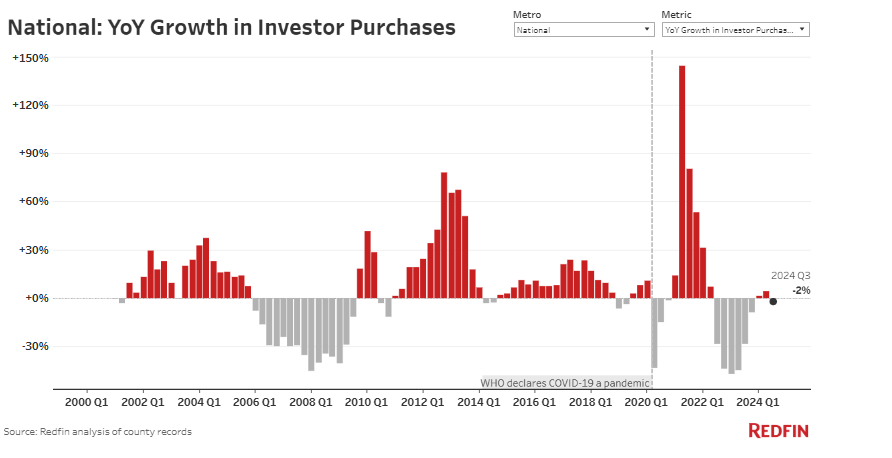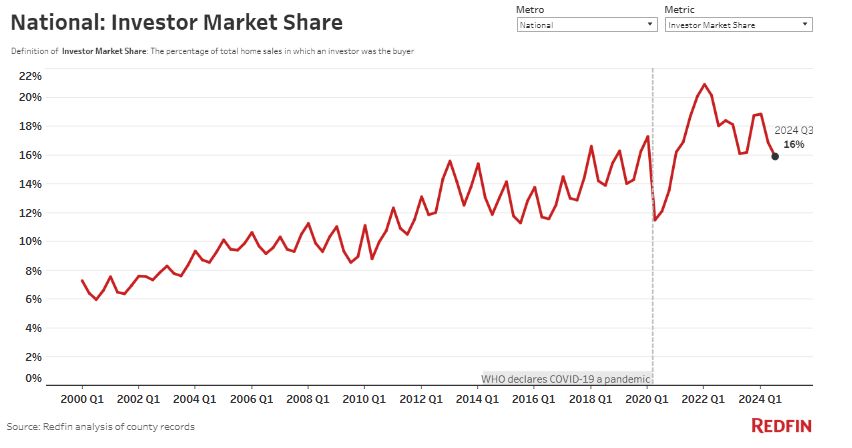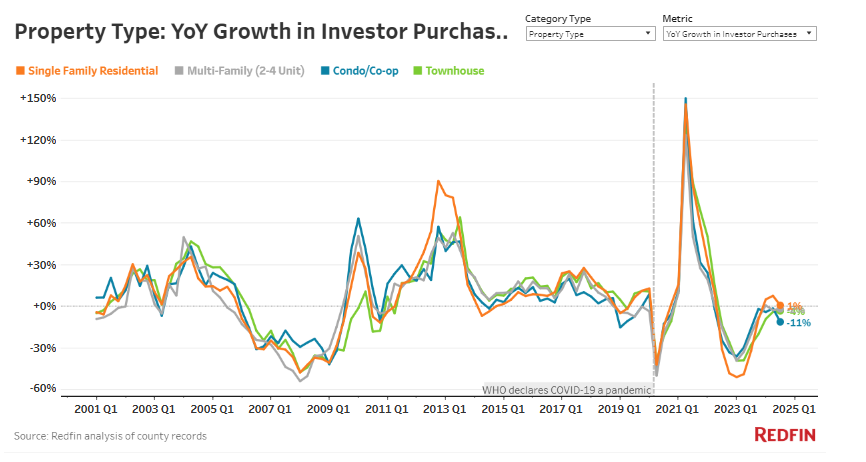A new study from Redfin found that real estate investors purchased 2.3% fewer homes in Q3 2024 than they did a year earlier. The small size of the change is notable because it comes after four years of huge swings driven by the wild pandemic-era housing market. For instance, investor purchases surged as much as 144% year-over-year in 2021, then dropped as much as 47% last year.
Investor home purchases have settled near pre-pandemic levels of around 50,000 per quarter, with typical seasonal difficulties. Investors bought 49,380 homes in Q3, compared with 50,535 last year. By comparison, investors were buying nearly 100,000 homes per quarter during the 2021 homebuying frenzy. In dollar terms, investors purchased $38.8 billion worth of homes in Q3—up 3.4% from a year earlier, similar to the increase in home-sale prices over the same period.
In September 2024, Redfin reported that 8.3% of home listings were from investors, down marginally from 8.7% a year earlier but up slightly from the pre-pandemic share.
“Investors are finding a balance after several years of whiplash: They bought up homes at a frenzied pace in 2021 and the beginning of 2022, then quickly backed off when the housing market slowed as mortgage rates rose,” said Redfin Senior Economist Sheharyar Bokhari. “Now there’s a middle ground. It’s less appealing to buy homes to flip or rent out than it was at the start of the pandemic, when demand from both homebuyers and renters was robust. But it’s more appealing than it was last year, when soaring home prices and borrowing costs put a big damper on demand.”

Investor Market Settles
There are a few key reasons investor activity is settling back to pre-pandemic levels:
- It’s harder for investors to buy homes, then sell them for a big profit than it was during the pandemic because home prices and loan costs are high. The typical home sold by an investor in October went for 55% more ($181,567) than the investor bought it for. That’s down from a 64% gain a year earlier. But interest rates are lower than a year ago and homebuying demand has improved a bit over the last few months. Investors who flip homes are still reaping bigger gains than they were before the pandemic, when homes bought by investors were selling for roughly 45% more. Just 7% of homes bought by investors sold for a loss in October; shortly before the pandemic, the norm was about 10%.
- A glut of new apartment supply hitting the market has put a lid on rent growth, meaning it’s less lucrative to buy a rental property than it was during the pandemic. But there is strong demand for rentals, largely because it’s hard for individuals to afford to buy a home. In fact, the number of renter households is growing three times faster than that of homeowner households. Rents have stabilized over the last year, but they’re still much higher than they were before the pandemic–and rents are rising quickly on the East Coast and in the Midwest.

Investor Share Falls
Redfin found that real estate investors purchased 15.9% of U.S. homes that sold in Q3, marking the lowest share since the end of 2020, though down just incrementally from 16.2% a year earlier. Investors’ market share has fallen to near pre-pandemic levels: In the third quarters of both 2018 and 2019, investors bought roughly 14% of homes that sold.
Investor market share hit a record high of 20.9% at the start of 2022, when investors were taking advantage of low mortgage rates to buy up properties during the pandemic-driven moving boom. Market share is evening out now because the number of homes investors are buying has returned to around pre-pandemic levels.

Sunshine State Losing Favor
While investor purchases are stabilizing nationwide, they are falling fast in some metros and rising quickly in others. Investor purchases fell most in Fort Lauderdale, Florida, where they declined 23.8% year-over-year. Next come Newark, New Jersey and Miami, Florida, which each posted 19.4% declines.
Investors are backing off from buying homes in Florida for similar reasons individuals are backing off: Florida has become a less desirable place to live as the intensity and frequency of natural disasters increase. Additionally, home insurance and HOA fees are skyrocketing.
Hurricanes Helene and Hurricane Milton both made landfall and wreaked havoc across the Sunshine State within just days of each other, as insurers paid out billions in claims.
In Las Vegas, investor purchases rose 27.6% year-over-year in Q3–the biggest increase of any metro in this analysis. Vegas was followed by Seattle, where investor purchases rose 21.8%, and San Jose, California, where they rose 19.5%.
Investor Purchases of Condos Dips
Investor purchases of condos fell 11.4% year-over-year during the third quarter, the biggest decline in a year. That’s compared to a 3.5% decline in purchases of townhouses, a 2.1% decline for multifamily properties, and a 0.5% uptick for single-family homes.
The downturn in investor activity in Florida partly explains why investor purchases of condos have fallen nationwide. Miami, for example, typically has the most condo sales of any major U.S. metro. But investor purchases of Miami condos have fallen 23.1% year-over-year, largely because demand for condos in Florida has fallen so much.
Investors bought far more single-family homes in the third quarter than any other property type. Single-family homes made up 69.9% of investor purchases, up from 68% a year earlier. Condos made up 18.2% of their purchases in the third quarter, down from 20.1% a year earlier. Townhouses made up 6.7% and multi-family properties made up 5.2%, both equal to the shares a year earlier.
In terms of market share, investors bought 16% of U.S. condos that sold in the third quarter, the lowest share in three years but down just marginally from 16.8% a year earlier. Investors bought 31.1% of multi-family properties that sold in the third quarter, 15.4% of single-family homes, and 14.9% of townhouses, all roughly unchanged year-over-year.

Additional Investor Highlights
- In Miami, investors bought 28.2% of all homes that sold in the third quarter, the biggest share of any metro in this analysis.
- Investors bought 7.8% of homes that sold in Providence, Rhode Island in Q3, the smallest share of the metros in this analysis.
- Investor market share increased most in Anaheim, California, rising to 24.3% from 22.2%.
- Even though investors still have the highest market share in Miami, it has fallen the most from a year ago, dropping to 28.2% from 31.2%.
- In Detroit, the typical home sold by an investor went for 135% more than they bought it for, the biggest gain among the metros in this analysis.
- The smallest capital gains were reported in Phoenix (32%), Las Vegas (34%), and Sacramento, California (39%).
- In Milwaukee, the typical home sold by an investor went for 97% more than they bought it for, up from a 31% gain a year earlier—the biggest gain among the metros Redfin analyzed.
- In roughly half of the metros in this analysis, investors’ median capital gain declined year over year. In Washington, D.C., the typical home sold by an investor went for a 45% premium, down from a 74% premium.






